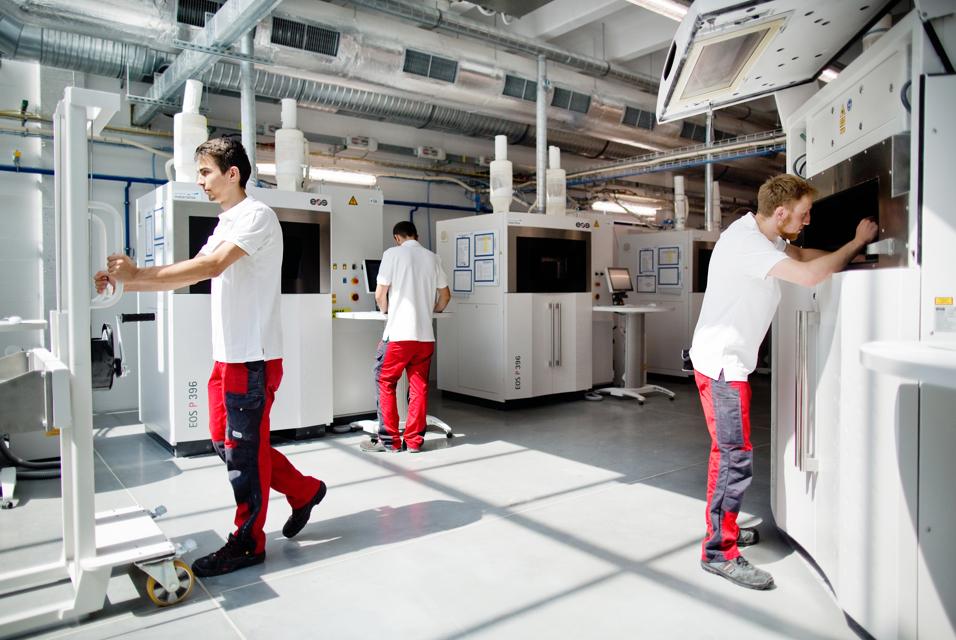EXPERT INSIGHT
5 Data-Driven Ways that Machine Monitoring Advances AM Facilities

The industry is experiencing a shift toward openness when it comes to machine language. Typically, each printer has its own individual language created by the machine manufacturer. But now, we are joining together with Trumpf, EOS, Stratasys, and more to encourage all machine manufacturers to adhere to one of the standard languages, namely MTConnect and OPC-UA, that independent software vendors, service providers, and software systems can easily interpret.
Once these standard languages are adopted, it creates the opportunity for 3D printing factories to turn to data-driven manufacturing — a must during Industry 4.0. It will be like finally seeing the dashboard display on their car after driving it for years without knowing its speed or engine temperature while in motion. They’ll have real-time, accurate, and objective data to refine decision-making, thus greatly increasing their productivity.
With this tool, machine monitoring, in hand, they can then advance their entire facility in the following ways.
1 - Real-time insight into machine performance
When machine operators take a look into their 3D printers’ real-time data, they gain a more comprehensive understanding of the overall equipment effectiveness. Production management software, such as Streamics, provides users with details on the printing process, such as how much time is left until the job is complete and if a build fails. It goes even further by giving a bird’s eye view of all of the facility’s printers at once.
Without machine monitoring, this data is unknown until the job is ready or the machine operator manually checks on the printer itself. There is an uncertainty in the printing process that prohibits team members from knowing all the facts and a disconnect between the production floor and management, which together limit productivity and decision-making. With machine monitoring, this data loop between the machine, planning software, and machine operators is seamlessly automated to ensure a well-connected production.
2 - Productive environments
Naturally, once they have this information, production managers can better schedule machine use. Build time may be predictable at this point, but with real-time insight into machine statuses, there will be no more guesswork involved. For example, identifying, resolving, and preventing problems will be greatly simplified and accelerated. These issues, which frequently hurt productivity, minimize the availability of machines and work throughput, limiting organizations’ returns on investment.
Machine operators can also gain more confidence in production scheduling and therefore better prepare machines to yield more in less time while providing better lead times for their customers. They will know the printers’ exact finishing times so the next build can begin as soon as the previous is completed. The entire production floor becomes streamlined and team members experience fewer disruptions in their work, such as checking whether a build is completed or not. They can see exactly when a print is ready from their workstation and waste much less of their valuable time.


3 - Efficient machine maintenance
A seemingly simple yet critical development from this improved efficiency is a more ordered machine maintenance procedure. The maintenance of 3D printers is necessary to ensure consistent production and part quality. Currently, this is completed in an unstructured way. Since production schedules are not clear enough without machine monitoring, planning maintenance is not optimized — the managers estimate best timings without the exact data, often after the machine’s performance declines. With automatically updated production schedules via machine monitoring and Streamics, organizations can easily bring order to their production’s chaos.
These managers need data via machine monitoring to be proactive about their machine maintenance, not reactive as things are at the moment. Now, facilities end up spending more time, effort, and money to solve machine issues than is needed.
Besides enhancing planned maintenance, machine monitoring also benefits unplanned maintenance. Imagine a machine is not running according to its set performance standards. The production team will receive an alert as to what the exact issue is, making it quicker and easier to both identify and fix the problem, thus creating less disorder in the 3D printing environment.
4 - Enhanced part quality
Another valuable benefit of machine monitoring is the capability to store this data to review over time. It holds more than just each job’s print time — it also includes the parameters and outcome of each build. It’s this information that gives the production team a clear view of which parameters resulted in the highest-quality builds.
By interpreting this accumulated data, the team can determine production trends, how to solve recurring problems, and more. From there, they can put these proven strategies into action over and over and expect consistent, high-quality parts each time.


5 - Additional scaling opportunities
A result of all of the advantages mentioned is something that many AM facilities are currently looking to do: scale up production. With day-to-day operations running reliably, requiring less manual labor, and creating more consistent products, there will be more opportunities for increasing production.
Whether that means ramping up production numbers on existing printers or investing in additional machines, machine monitoring enables a foundational workflow and software system that is easily scalable.
No longer will teams be wandering the production floor, uncertain of the machines’ true schedules or build outcomes. They can be on the phone, collaborating, coordinating customer relations, improving the ordering process, exploring relationships with new customers — all crucial actions to increase production numbers.


This is the future we see in our industry because of the steps initiated by both machine monitoring and standard languages. We envision reliable, sustainable AM facilities, thriving productions, and, therefore, a global draw to 3D printing for manufacturing.
Share on:
You might also like
Never miss a story like this. Get curated content delivered straight to your inbox.
